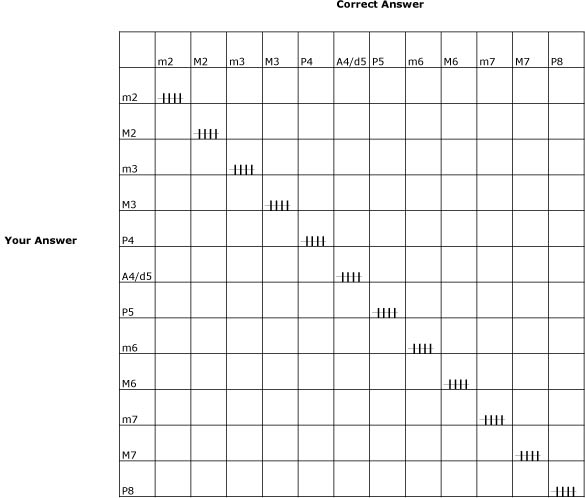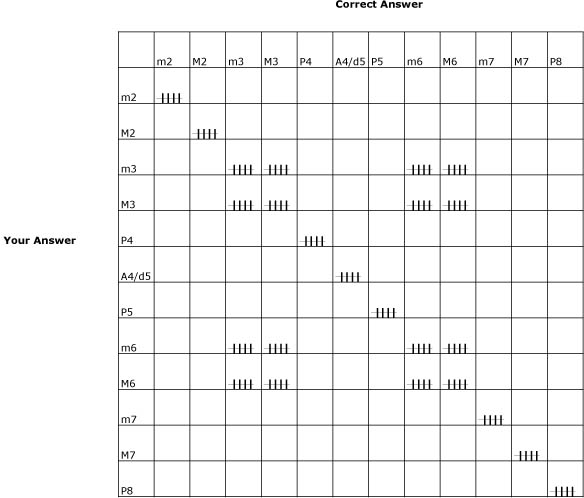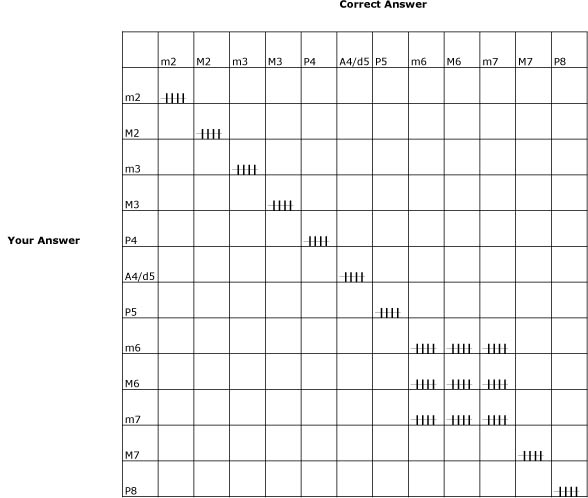- AURAL SKILLS
- Aural Idiom Drill: Practice with Harmonic Idioms
- Intervals and Chords with MacGamut
- Learning to Hear Chords in Popular Music
- Hearing Form
(coming soon) - MUSIC THEORY
- Theory Fundamentals
- Harmony 1 and 2
(CMU only) - Form Notes
- Species Counterpoint in Analysis and Composition
- Transposing Instruments
- 19th Century
- 20th Century
- WELLNESS
- Healthy Balance Statement
- Wellness Wednesday Videos
Instructions on Using the MacGamut Worksheets
This page has two sections: Choosing Settings and Using the Worksheets
Choosing Settings on MacGamut 6
When you start MacGamut, you must first choose select either "Intervals" to drill intervals or else "Chords" to drill triads or seventh chords.
At the next menu, always choose "Make My Own Drill".
On the next screen you will make several choices.
In the middle of the window is the first of the choices, of kind of drill -- for work with aural skills, always choose "Aural Training".
If you have chosen to practice intervals, check the boxes for all of the intervals that you will be practicing. Check both "melodic ascending" and "melodic descending" for melodic intervals, and check "harmonic" for harmonic intervals.
If you have chosen to practice chords, check the boxes for whichever triads or seventh chords you will be practicing. Note that the left most column contains the triads, and the next column contains the seventh chords. Check the boxes for the inversions that you will practicing, and check either "single staff" or "grand staff". Finally, choose either "blocked, arpeg." or else "blocked only".
MacGamut does not allow you to choose the number of hearings. For worksheets with two hearings, use both hearings if you need them. For worksheets with a single hearing, you much choose not to use the second hearing, even though it will always be available.
Using the Worksheets
This kind of practice is most effective when you practice frequently, doing only a moderate amount of practice on each session. I usually have my students do twenty individual drills per session, but you are doing this as an assignment you should follow whatever instructions you are given.
Download the worksheet the corresponds to the kind of practice you want to do, and use that worksheet repeatedly for several sessions (I usually recommend four.)
The worksheets all present simple grids. The left column is labeled "Your Answer", and the top row is labeled "Correct Answer". Each time you make a guess, select the (horizontal) row corresponding to the answer you chose, and once you have found out the correct answer, select the (vertical) column corresponding to that interval. Make a tick mark in the box where the row of your answer and the column of the correct answer meet. (Use the tallying system in which you start with four vertical tick marks and then make a diagonal tick mark across the previous four.)
To illustrate, suppose that you are practicing intervals, and you think you hear a major second, but the interval is really a minor second. You would then make a tick mark in the box that is all the way to the left and one down from the top within the body of the chart.
The point of this somewhat elaborate system is to create an easy to read graphic record of the intervals you tend to get right and the intervals that you sometimes get wrong.
Once you have done enough sessions to establish meaningful trends, look over your worksheet. All of the correct answers fall along the main diagonal (the diagonal line that runs from the upper left-hand corner to the lower right-hand corner). Any other tick marks on the chart represent wrong answers. Here is an example of a chart in which there were no mistakes.

Clusters of wrong answers reveal the mistakes that you tend to make, and they point toward further work with MacGamut. Suppose that you tend to confuse thirds and sixths, but identify other intervals correctly. You can do a custom drill in which you select only thirds and sixths for drill. In this way you are not wasting time practicing things you already know well, but instead are able to focus your work on your weak areas. Here's what a worksheet would look like for a student who confused thirds and sixths but identified other intervals correctly. As you can see, the problem is readily apparent.

Another typical problem is one I call the "roving band of confusion" -- roving because many students have trouble with a few intervals somewhere in the range from perfect fifth to major seventh, but with the exact location of the band of difficult intervals variable from student to student. The following worksheet illustrates, and points toward the custom drill that would most efficiently address this.

Sometimes you may have overlapping problems. For example, you might both confuse thirds and sixths and also confuse intervals between a minor sixth and a minor seventh. This represents two separate problems: confusing imperfect consonances that are inversions of each other, and confusing intervals of a certain size range. You will make the most progress if you practice these two sets of intervals separately, rather than doing a drill on thirds, sixths, and sevenths. (In cases like this you should probably seek advice from your instructor or from a theory tutor.)
Finally, it is also possible that your worksheet may be covered fairly evenly with wrong answers, with no particularly clear trends. This indicates that you need to be doing a simpler drill. Switch from grands staff to single staff on chords, on triads go back to root position only if you are working with inversions, etc. In some cases you may need to create a simpler drill than worksheets exist for (e.g. simple melodic intervals, ascending only, from m2 to P5 only). Again, consulting your instructor is probably a wise idea.
